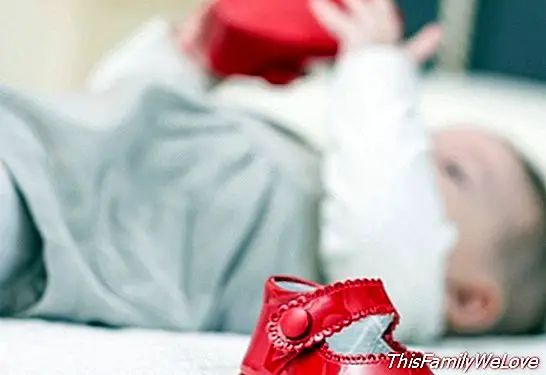Keys to choose the first baby shoes

The feet of a baby are very delicate because they are in the process of formation. We parents have to be careful when it comes to protecting and fitting their little feet, and it is not easy, because the baby's growth sets different standards when it comes to covering this vulnerable part of the body.
Fitting a baby is not a trivial matter. The feet of our little one are going to sustain him for the rest of his life, and for that, we have to pay special attention and care.
Baby shoes: three categories according to age
1. Babies who do not walk
The Pediatricians recommend keeping the baby's foot bare until it starts to crawl and take your first steps, in order to develop muscle strength and correct grip of the fingers. But in case it's cold, we should shelter our son's little feet, and how do we do it? Since the baby does not walk, does not need shoes, and with socks or booties will be very good. These should be made of soft, comfortable, airy and soft materials, such as wool, fabric, leather, canvas or knit. Everything as comfortable as possible, and taking care not to cause friction or discomfort.
2. Baby's first steps
When our baby begins to discover the world, to crawl, to explore and to stand, it is still recommended that he continue with bare feet until he walks with some security. But in case you want to cover your feet to avoid damage and cold, we can do it with "learning shoes", that is, with light footwear, soft fabrics, hypoallergenic and anti-slip base, so that the baby can practice with safety, grip and grip.
3. Walking baby shoes
It is now when you are going to need your first shoes, some real shoes. For this, we will look for a footwear that allows freedom of movement and made with natural materials, such as leather, lining and capellada, and that also has a buttress to give stability and firmness to the feet of the baby.
Footwear for children who start the school year
For the beginning of the school year, Asepri (Spanish Association of Products for Children) warns that parents must take into account the importance of choosing appropriate shoes for the school stage in order to prevent future problems in the development of the feet, make them comfortable, of quality materials, breathable and that hold the foot well. Also highlights the need to get the right size, so that it is not tight or large, as in the latter case can cause kinks or falls due to lack of support.
Footwear must be of natural fibers, leather or canvas that allows perspiration to avoid irritations and the appearance of fungi. It is recommended that you have the anti-slip soles Y flexible material that does not impede their movements. Also, advise not to use the same shoes every day and not use borrowed or inherited shoes.
Tips for children's first shoes
- We must not fit a baby with shoes until he starts walking. Also, we should not force him to walk.
- Your first shoes must be soft and very soft, preferably of skin.
- Pay attention to these situations: the shoes have deformities or abnormal or excessive wear, the alterations in the shape of the bridges or arches (plantar vault), especially if the child shows pain; and the bad alignment in the leg-foot area at the level of the ankles (heel outwards or inwards).
- Baby shoes usually have applications and ornaments, watch that they are well sewn, since they can get the attention of the little one and put them in their mouths.
- Do not buy shoes of larger sizes for the baby that already walks with the idea to save and that it serves him for more time. At the most, we have to try to get him a few millimeters so he can move the little fingers.
Cristina Murcia
You may also like:
- Abnormalities in children's feet
- Baby bootees two needles: explanatory videos to make them at home
- First steps, the ideal shoes for children
- Learning to walk, the first steps of the baby
- Is my baby ready to learn to walk?




